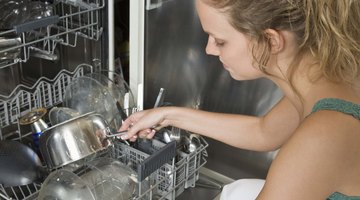What Are the Little Balls in the Bottom of the Dishwasher?
You often see items such as utensils and food particles on the bottom of a dishwasher, but if you see little white balls on the bottom of the dishwasher, you have a problem. The balls are from the pump, which means that the pump will need to be accessed in order to replace or return the check balls.

Dishwasher Pump
The two small white balls that you found in the bottom of the dishwasher, called check balls, are part of the dishwasher pump assembly, which is responsible for moving water out of the unit. Before you can return or replace the balls, you must access the pump. Disconnect power to the dishwasher and then open the dishwasher door, slide out the bottom rack, and turn the spray arm and the spray arm support in a counterclockwise motion to remove the spray arm housing. The pump is inside the housing for the spray arm.
Disassembling the Pump
Once you have reached the pump, the pump must be taken apart to reach the part where the check balls are usually situated. Remove the eight screws holding the pump cover to the outlet, then lift off and remove the seal from around the pump. Under the seal is a screw assembly that can be removed with an adjustable wrench and then the wash impeller, which is a small round disc, can be lifted out. After removing the impeller, take out the three screws that hold the separator in place, which is the larger round disc around the separator screw assembly. Take out the separator and then remove the screw holding the inlet base into the separator. A perforated plate is under the inlet base with a small hole on the lower right side where the drain check balls should be.
Check Balls
Replace the white balls into the small opening on the separator assembly base and then ensure a gasket is underneath the inlet base that sits on top of the drain check balls. If the gasket is broken or missing, that might be why the drain check balls fell out in the first place. Contact your dishwasher manufacturer or another qualified service professional for assistance. If the gasket is in place and the perforated plate that holds the drain check balls does not seem to be damaged or broken, move in reverse order to reassemble the impeller and the spray arm housing.
Drain Check
After you replace the balls and reassemble the dishwasher, run a normal wash cycle and monitor the dishwasher to ensure that the unit drains properly. If the dishwasher doesn’t drain correctly, the drain check valve might need to be inspected or repaired. Open the bottom front panel and set an empty container down, and then remove the drain hose and set the end of the hose into the container. Remove the other end of the drain hose from the connection point on the garbage disposal or air gap and blow some compressed air through the drain hose. This will help remove any obstructions. While the hose is disconnected, reach into the dishwasher housing and unscrew the check valve, which is normally connected to the drain hose. Ensure that the flapper on the valve can open and close. If the flapper does not operate, the valve will need to be replaced. Look inside where the valve is connected as well to see whether any debris is causing a blockage. Clean if needed, then replace the valve and the drain hose. Contact an expert if the problem continues.
The Drip Cap
- You often see items such as utensils and food particles on the bottom of a dishwasher, but if you see little white balls on the bottom of the dishwasher, you have a problem.
- Contact your dishwasher manufacturer or another qualified service professional for assistance.
- If the dishwasher doesn’t drain correctly, the drain check valve might need to be inspected or repaired.
- This will help remove any obstructions.
- While the hose is disconnected, reach into the dishwasher housing and unscrew the check valve, which is normally connected to the drain hose.
- Ensure that the flapper on the valve can open and close.
Writer Bio
Meredith Jameson writes early childhood parenting and family health articles for various online publications. She holds a Bachelor of Arts in history from San Francisco State University.
Photo Credits
- Jupiterimages/Goodshoot/Getty Images
- Jupiterimages/Goodshoot/Getty Images
More Articles



